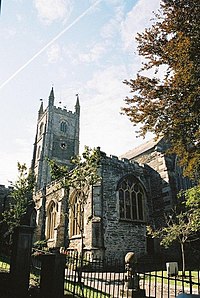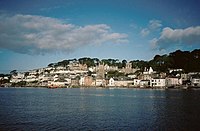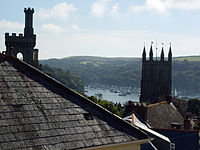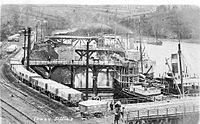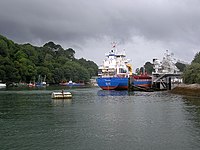Fowey
| Fowey Cornish: Fowydh | |
| Cornwall | |
|---|---|
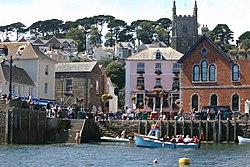 Fowey, Town Quay | |
| Location | |
| Grid reference: | SX126516 |
| Location: | 50°20’2"N, 4°37’59"W |
| Data | |
| Population: | 2,273 (2001) |
| Post town: | Fowey |
| Postcode: | PL23 |
| Dialling code: | 01726 |
| Local Government | |
| Council: | Cornwall |
| Parliamentary constituency: |
South East Cornwall |
Fowey (pron. [fɔɪ]) is a small town and cargo port at the mouth of the River Fowey in south Cornwall.
Fowey is in the Cornwall "Area of Outstanding Natural Beauty" and at the end of the Saints' Way. There are many historic buildings in the town, including the ruins of St Catherine's Castle and a fine local beach at Readymoney Cove
Both vehicle and foot ferry services cross the river, to Bodinnick and to Polruan (on foot only). A ship to shore water taxi service operates from Easter until the end of October and a foot ferry to the fishing village of Mevagissey runs fom 1 May to 1 October, weather permitting.
Contents
Churches
At the entrance to the River, on the eastern side below the cliffs to the southwest of St Saviour's Point, there is a cross to commemorate a blasphemous local tale that Jesus sailed to Fowey as a boy; this cross is marked on very early charts and was maintained by monks from Tywardreath, who no doubt welcomed the open-pursed pilgrim traffic their story brought. The cross is known locally as "Punches Cross", supposedly derived from the name of Pontius Pilate.
One hundred yards west of the lighthouse on the west of the harbour entrance, about thirty feet below the top of the cliff edge and broadly concealed, is a small grass area known as "Johnny May's Chapel". This name is believed to be that of a Methodist preacher at the time when Nonconformism was struggling fr acceptance here.
Fowey Parish Church
The parish church is dedicated to St Finbarr and is listed Grade I. It was built in the early 14th century and rededicated in 1336, replacing a previous Norman church. The church was damaged by the French in 1457, and repaired in 1460 by the Earl of Warwick, when the clerestory and the north and south aisles were rebuilt.
There is a nave and two aisles with a clerestory, and the aisles are unusually wide; the aisles and the clerestory may be additions of the 15th century. The tower, of the 16th century, is of four stages and has buttresses and bands of ornament. There is an exceptionally fine 15th century carved wagon roof. The south porch has open arches to the west and east and an eight-ribbed vaulted roof. The font is Norman, of Catacleuze stone, and similar to those of Ladock, Feock and St Mewan. The hexagonal pulpit was made in 1601. The monuments include two brasses of the mid 15th century and those of John Rashleigh, 1582, and Alice Rashleigh, 1602. The most interesting are two later Rashleigh monuments: John Rashleigh, ca. 1610, and another of 1683.[1] The church was used as a town hall for a period up to 1684.
History
Early history
The Domesday Book survey at the end of the 11th century records manors at Penventinue and Trenant, and a priory was soon established nearby at Tywardreath. Circa 1300 the prior granted a charter to people living in Fowey itself. This mediæval town ran from a north gate near Boddinick Passage to a south gate at what is now Lostwithiel Street; the town extended a little way up the hillside and was bounded on the other side by the river where merchants had their houses backing onto the waterfront. The natural harbour allowed trade to develop with Europe and local ship owners often hired their vessels to the king to support various wars, although the town also developed a reputation for piracy, as did many others at this time. In the 14th century the harbour was defended by 160 archers; after these were withdrawn, two blockhouses were built on either side of the harbour entrance. Despite these defences the town was attacked by French forces in 1457. Place House, by the church, was successfully defended against the French but subsequently strengthened. This building still exists, but much remodelled. A small castle was built on St Catherine's Point, the western side of the harbour entrance, around 1540. The defences proved their worth when a Dutch attack was beaten off in 1667.[2]
The people of Fowey generally sided with the Royalists during the Civil War, but in 1644 the Earl of Essex brought a Parliamentarian army to Lostwithiel and occupied the peninsula around Fowey. In August, a Royalist army surrounded Essex's troops and King Charles I himself viewed Fowey from Hall Walk above Polruan, where he came close to being killed by a musket shot. On 31 August, the Parliamentarian cavalry forced their way through the Royalist lines and retreated towards Saltash, leaving the foot soldiers to be evacuated by sea from Fowey. Essex and some officers did indeed escape, but the majority of the force surrendered a few days later near Golant and were then marched to Poole, but most died before reaching there.[2]
Later history
The fortunes of the harbour became much reduced, with trade going to Plymouth and elsewhere instead. Fishing became more important, but local merchants were often appointed as privateers and did some smuggling on the side. Tin, copper and iron mines, along with quarries and china clay pits became important industries in the area which lead to improvements at rival harbours. West Polmear beach was dug out to become Charlestown harbour circa 1800, as was Pentewan in 1826.[3] Joseph Austen shipped copper from Caffa Mill Pill above Fowey for a while before starting work on the new Par harbour in 1829.[4] Fowey had to wait another forty years before it saw equivalent development, but its natural deep-water anchorage and a rail link soon gave it an advantage over the shallow artificial harbours nearer to the mines and china clay works. Meanwhile, a beacon tower was erected on the Gribben Head by Trinity House to improve navigation into Fowey and around Par bay.[3]
The Fowey Harbour Commissioners were established by an Act of Parliament in 1869, to develop and improve the harbour.[3] On 1 June in that year, the 7 ft broad gauge Lostwithiel and Fowey Railway was opened to new jetties situated above Carne Point, and in 1873, the standard standard gauge Cornwall Minerals Railway (CMR) opened a line from Newquay and Par to further jetties between Caffa Mill Pill and Carne Point. Both of these railways initially carried just goods, but on 20 June 1876, a passenger station was opened on the CMR on land reclaimed from Caffa Mill Pill. The Lostwithiel line closed at the end of 1879 but was reopened by the CMR as a standard gauge line in 1895, and the short gap between the two lines at Carne Point was eliminated. Passenger trains from Par were withdrawn after 1934 and from Lostwithiel in 1965. The Par line was subsequently converted to a dedicated roadway for lorries bringing china clay from Par after which all trains had to run by way of Lostwithiel.[5]
The Royal National Lifeboat Institution established Fowey Lifeboat Station near the Town Quay in 1922 to replace an earlier station at Polkerris. This was replaced in 1997, by a new facility in Passage Street.[6] Two lifeboats]] are stationed at Fowey: Maurice and Joyce Hardy, a Trent Class all weather boat that is kept afloat opposite the lifeboat station, and Olive Two, an IB1 inshore lifeboat kept inside the station and launched by davit.[7]
Governance
Fowey was once a borough; one of many tiny boroughs in Cornwall. The seal of the borough of Fowey was On a shield a ship of three masts on the sea her topsail furled with the legend "Sigillum oppidi de Fowy Anno Dom. 1702".[8]
As a borough, Fowey elected two members to the House of Commons until the Reform Act 1832 stripped it of its representation as a rotten borough, it having lost its borough corporation a few years before.[9] It was restored as a municipal borough in 1913, which lasted until a reorganisation in 1968.
Economy
Fowey has thrived as a port for hundreds of years, initially as a trading and naval town, then as the centre for china clay exports. Today Fowey is busy with trawlers and yachts. Tourism is also an important source of income, contributing £14m to the local economy and accounting for more than half of the jobs in the town.[10]
Culture
Fowey has been the inspiration for many authors including Sir Arthur Quiller-Couch ('Q'), Daphne du Maurier and Kenneth Grahame. The town was Q's main residence from 1892 onwards and a number of his stories are set in 'Troy Town', a thinly-disguised Fowey. The Daphne du Maurier Festival is held in Fowey each May,[11] the month of her birth.
The town hosts a Christmas market over the last weekend in November.
Literary figures
- Daphne du Maurier (1907–1989) author and playwright. Her works include Rebecca, Jamaica Inn, Frenchman's Creek and many other famous works, and numerous short stories including The Birds and Don't Look Now that were turned into films.
- Kenneth Grahame (1859–1932) most famous for The Wind in the Willows (1908) lived for part of the year in Fowey during the 1890s and into the early part of the 20th century.[12]
- Sir Arthur Quiller-Couch (1863–1944) settled in Fowey in 1891 and remained there for the rest of his life.[13] Quiller-Couch was an author and professor of English literature primarily recalled for his influential literary criticism.
Sports
The surrounding coastline of Fowey is popular with fishermen and spear-fishermen. Many sea creatures can be seen all around the Cornish shoreline, including mullet, bass, mackerel, lobsters and cuttlefish. Many of the species can be seen in the Fowey Aquarium in the heart of the town, which includes a very rare Albino Bull Huss. The seafood served in many of Fowey's restaurants comes from the Fowey estuary, or the sea just outside it. The Royal Fowey Yacht Club is based on the harbour front.[14]
A Pilot Gig Rowing Club that races in and around Cornwall, with an event at Fowey being held the same week as the Regatta. The club launches from Caffa Mill slip.
Outside links
| ("Wikimedia Commons" has material about Fowey) |
References
- ↑ Pevsner, N. (1970) Cornwall; 2nd ed. rev. Enid Radcliffe. Penguin; p. 70
- ↑ 2.0 2.1 Keast, John (1987) [1950]. The Story of Fowey. Redruth: Dyllansow Truran. ISBN 1-85022-035-2.
- ↑ 3.0 3.1 3.2 Ward-Jackson, C. H (1986). Ships and Shipbuilders of a Westcountry Seaport: Fowey 1786–1939. Truro: Twelveheads Press. ISBN 0-906294-11-8.
- ↑ Keast, John (1982). The King of Mid-Cornwall. Redruth: Dyllansow Truran. ISBN 0-907566-29-4.
- ↑ Vaughan, John (1991). The Newquay Branch and its Branches. Sparkford: Haynes/Oxford Publishing Company. ISBN 0-86093-470-5.
- ↑ Leach, Nicholas (2002). Fowey Lifeboats, an Illustrated History. Stroud: Tempus Publishing. ISBN 0-7524-2378-9.
- ↑ Denton, Tony (2009). Handbook 2009. Shrewsbury: Lifeboat Enthusiasts Society.
- ↑ Pascoe, W. H. (1979). A Cornish Armory. Padstow, Cornwall: Lodenek Press. p. 133. ISBN 0-902899-76-7.
- ↑ Fowey – LoveToKnow 1911
- ↑ "South West Business Figures reveal Fowey tourists are worth £14m to the town". http://www.southwestbusiness.co.uk/news/Figures-reveal-Fowey-tourists-worth-163-14m-town/article-2485936-detail/article.html.
- ↑ Daphne du Maurier website
- ↑ "The Literature Network". http://www.online-literature.com/grahame/.
- ↑ Brittain, F. (1948) Arthur Quiller-Couch. Cambridge: University Press
- ↑ Coombs, Joan (2000). A Fowey Jig-Saw: the History of the Royal Fowey Yacht Club. Fowey: RFYC Books. ISBN 0-9539622-0-2.
Books
- Henderson, Charles (1935) Fowey. In: Essays in Cornish History edited by A. L. Rowse and M. I. Henderson; pp. 26–43
